But the reality is that producing a wholesome beef product and delivering it to the consumer takes time as well as good nutrition, technology, manpower and care in the finishing phase.
Perhaps one of the most unsung heroes in this process is the important and necessary role of the feedlot pen rider.
The No. 1 job of these often quiet and unassuming cowboys and cowgirls is to ride quietly through pens, monitoring cattle for signs of sickness, stress or injuries, and then pulling out these calves and driving them to a nearby on-site hospital for treatment.
According to University of Nebraska Feedlot Extension educators, pen riders and cattle processors play a major role in the beef food chain.
They say the majority of beef entering the food chain in the U.S. will come from beef animals that have been processed and handled by pen riders and processors in a beef feedlot.
While today’s modern feedlots are high tech, working cattle on horseback is still one of the most effective ways to monitor animal health and move cattle in all types of weather.
At larger feedlots such as Simplot Livestock Co., Grand View, Idaho, cattle are moved daily, whether they be incoming, outgoing or moved within this expansive facility that encompasses some 700 acres in the southwest corner of the state.
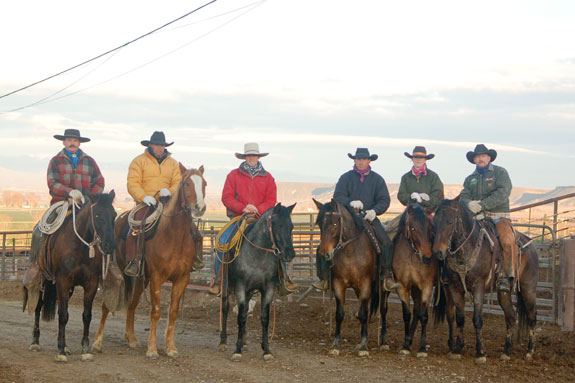
Horseback all day
It’s cattle manager Shawna Mahon’s job to oversee all pen movements and pen riders at this feedlot that, this spring, had 60,000 head of cattle on feed, some 60 percent of those for Northwest customers.
Mahon’s 17-member horseback crew includes one full-time receiver, a shipper, lead pen rider and 14 cowboys and cowgirls.
Their days start early, and 12 members of this crew ride out of the barn daily at 7 a.m., rain, shine, wind or cold.
They’re responsible for checking some 600 pens of cattle before lunch. During their workday, they’ll also pull and move market-ready cattle from pens, move cattle to and from the processing barns for re-implanting, pull sick and move treated cattle to and from this feedyard’s eight different hospitals and drive newly received cattle from the processing barn to their home pens.
Their day ends about 4:30 p.m., but looks a little different in fall when they’re receiving cattle. In fact, last September to November, they received 47,000 head of calves, many unweaned.
In summer they start earlier, before the heat. Simplot pen riders work two sets of seven days on, two days off, and then seven days on, three days off.
“It’s a riding job,” Mahon points out. “They are horseback all day,” – a definite drawing card for many of this feedlot’s pen crew members, for whom horses and cattle have been a chosen way of life.
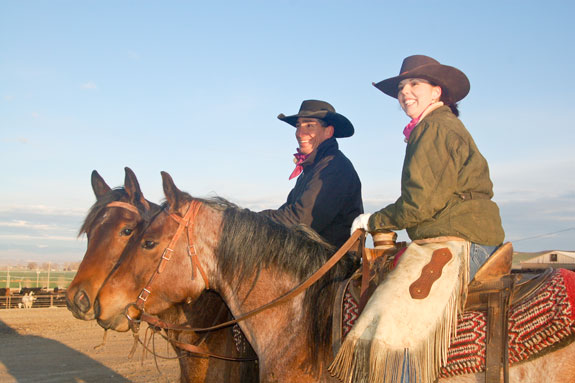
Mahon hires pen-rider positions, and says horsemanship and cattle-handling skills are a must.
She explains that many current riders have worked mostly big ranches their whole lives, from Oregon and Nevada to Wyoming and Arizona.
“There is a lot of pride involved in their gear, horsemanship and the way they handle the cattle,” she remarks.
“A lot of these guys are cow-calf guys who are retrained,” she says. They grew up on big country, so the feedlot is definitely a change for them.
The signs and symptoms they’re looking for in the feedlot versus cow-calf are somewhat different and come on quicker. “But the cowboys catch on really fast because they’ve been around cattle their whole life.”
Compared to other positions at the feedlot, there is more turnover in pen riders. But lead rider Ron Apodaca has been at Simplot for 17 years, and others have been on for 15 years.
Getting to work bright and early has never been a big deal for Apodaca and other riders. “It’s just an everyday deal.
We’ve been doing it our whole lives,” he remarks. He too worked on ranches in Nevada and Oregon. “It’s all I’ve ever done.”
Cole Arrowsmith has been at Simplot eight years, previously coming off big outfits in Oregon and Wyoming, while Mitch Miller rode his first pen of cattle at age 9 at Harris Ranch in California.
Riley Timmons, who oversees receiving and starts company colts, grew up at Simplot. His dad was the previous cattle manager there and now works for Simplot’s Western Stockmen’s Supply.
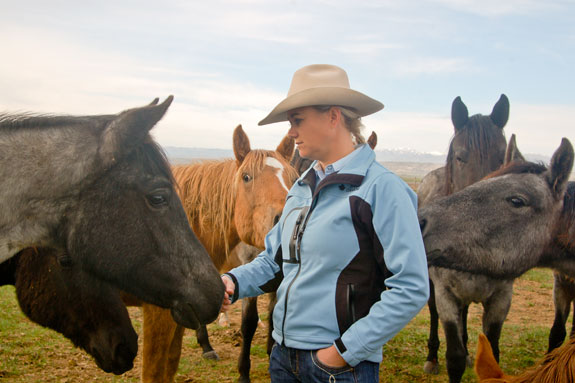
Mahon herself has been with Simplot for 12 years, working her way up to a manager position by riding pens, running receiving, shipping and working as a feed boss for five years.
She also grew up on large Western ranches and, as a child, her dad ran the expansive ZX Ranch in Oregon, now owned by Simplot. Her mom oversaw the horse breeding program there in the early 1980s.
Horses are a drawing card
For many, including Timmons, Nicole Cleaver and Bije Lowe, their favorite part of the job is the horses. Simplot provides company horses for pen riders, or they can ride their own.
Mahon says horses need to be “cowy,” because riders are always sorting cattle. And they need to be gentle, because safety is a huge consideration. I
t’s not unlike some colts to buck a little bit. “But if they don’t get over it real fast,” she says, “they’re down the road.”
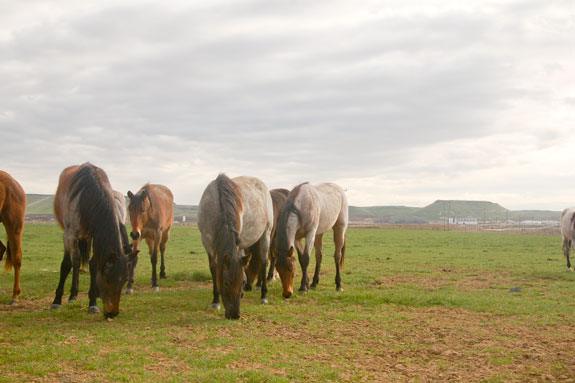
Simplot actually raises its own horses for the feedyard. It has 23 mares in its mare band, which runs year-round on grazing lands in the Owyhee Mountains.
When their stud, Shining Blue Spark, isn’t breeding mares, he’s ridden by Timmons and working in the feedlot.
Mahon, a horseperson herself, says that starting his colts is a non-event. “They’re real cowy, but there is spunk in them. They’re just really agreeable.”
Health is the focus
At large cattle feeding operations like Simplot, pen riders and horses partner to carry out the monitoring of animal health.
This horseback crew oversees extensive investments of cattle. At this feedlot, the ratio is some 6,000 head to one rider.
Scott McNeley, Simplot Livestock Co.’s general manager of cattle feeding, remarks, “They (pen riders) are critical.
They’re our first line of defense against disease. The animal health perspective is their most important job – identifying sick animals early.”
Mahon adds, “They’re basically my eyes and ears and are the ones out there looking at the cattle on a daily basis.
“Our main goal is to keep cattle from getting sick,” she explains. “Goal No. 2 is when they do get sick, catch them early, get them treated and home with the least amount of cost to the customer.”
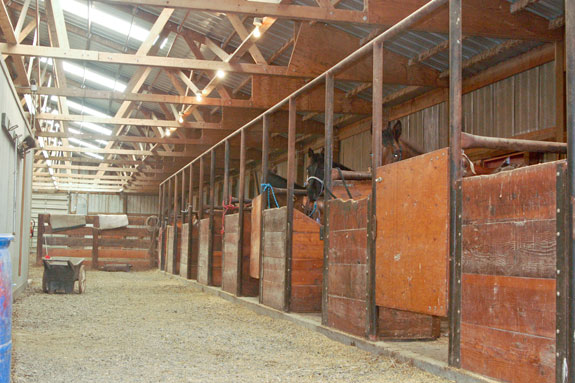
Communication at Simplot is key to keeping on top of animal health, and pen riders play an integral role.
Their communication with Mahon and staff veterinarians help decide how best to proceed with a pen of cattle that may be on the edge of breaking.
“When you do have those pens break with sickness, the thing is to catch them early and get them straightened out, back on feed and going,” Mahon explains.
Furthermore, all new cattle are given additional exercise for the first week, a policy mandated by Mahon as cattle manager.
She explains, “We take them out of the pen, down the alley and let them go back into the pen, optimally every day for the first week.
That adds a little bit of time, but in the end I think it saves a lot.” She adds, “The guys who are out there riding the calves really believe in it now.”
“Cattle are sensitive to stressors,” relays staff veterinarian Randall Raymond. “Exercise tends to make cattle more comfortable with surroundings and pens.”
Lead cowboy Apodaca says this practice gets the calves up and moving around. “You can find the sick and weak faster.
It also gets them eating.” Timmons believes the calves like it after a few days. “They almost look forward to seeing you,” he says, and they start running, bucking and kicking.
Wendy Miller, one of three cowgirls who rides pens, adds, “It seems to really help them – at the end of the week, the calves are really relaxed and there are less pulls.”
If health issues arise even in older cattle, Simplot pen riders will walk those too.
McNeley relays that animal welfare has always been important to this feeding enterprise. “Whether cow-calf or feedlot, animal welfare has to be top of mind in order to be profitable.”
Constantly looking for ways to handle cattle better for the benefit of health, Simplot spends a lot of time emphasizing low-stress handling, like exercise, with its crew.
“We feel it’s the right way to do things from cattle health and financial standpoints,” Mahon remarks.
They regularly bring in outside consultants such as low-stress handling experts Bud Williams and Tom Noffsinger, DVM.
Raymond drives the pens regularly and consults with pen riders, and Mahon holds weekly meetings with the pen rider crew and veterinarians.
She’s put an incentive program into play, modeled after the board game Monopoly, which rewards for healthy pens and locating strays.
She’s also taken crew members to the packing plant to witness the final end product they’ve had a hand in caring for.
“We’re just trying to get them to think about the big picture of things,” Mahon explains. “At the end of the day, we’re feeding families.” ![]()
PHOTOS
PHOTO 1: Moving cattle to and from the processing barn is part of the day’s work for the Simplot horseback crew. Pen riders work in some ‘pretty tough’ conditions, says Shawna Mahon, so horses need to be really sure-footed.
PHOTO 2: Part of the animal husbandry/health checking crew at Simplot are, from left, Bije Lowe, lead cowboy Ron Appodaca, receiver Riley Timmons, Riley and Nicole Cleaver, and Troy Anderson. It’s the first day on the job for the colt being ridden by Timmons, who also breaks all Simplot-bred colts for the feedlot.
PHOTO 3: One of two married couples who ride for Simplot, Riley and Nicole Cleaver are from cow-calf backgrounds in Oregon with prior feedlot experience. Cattle need checked in all types of weather, and Nicole cites harsh elements as one of the challenges of this job.
PHOTO 4: Cattle manager Shawna Mahon befriends 2-year-old colts.
PHOTO 5: Shining Blue Spark-sired 2-year-old colts are from Simplot’s 23-head broodmare band used to produce colts for feedlot use. The 7-year-old blue roan stud was purchased from the Davis Ranch in northern Utah in 2006. His pedigree is filled with working cowhorse, cutting, reining, heading and heeling accolades.
PHOTO 6: Stables. Photos by Kim Holt.







